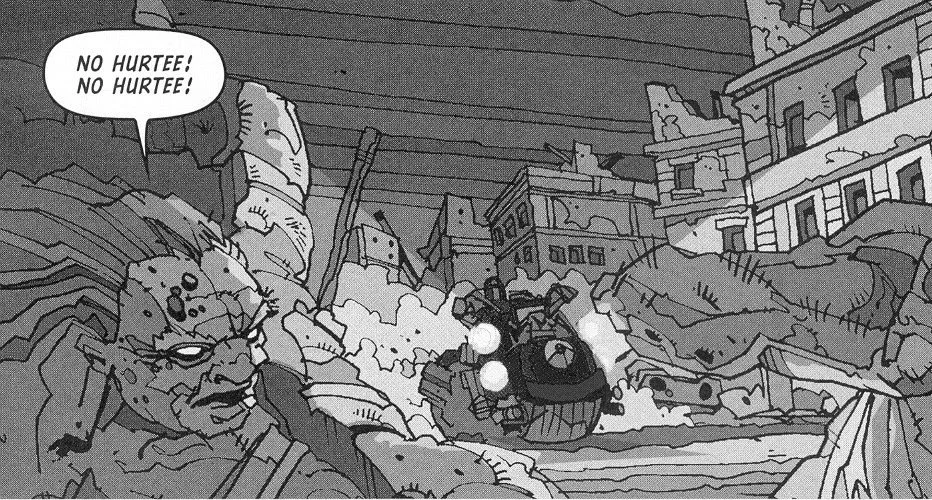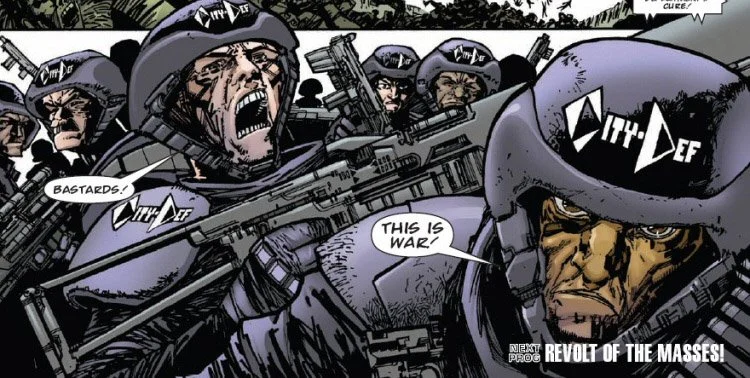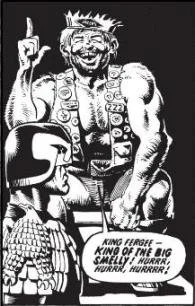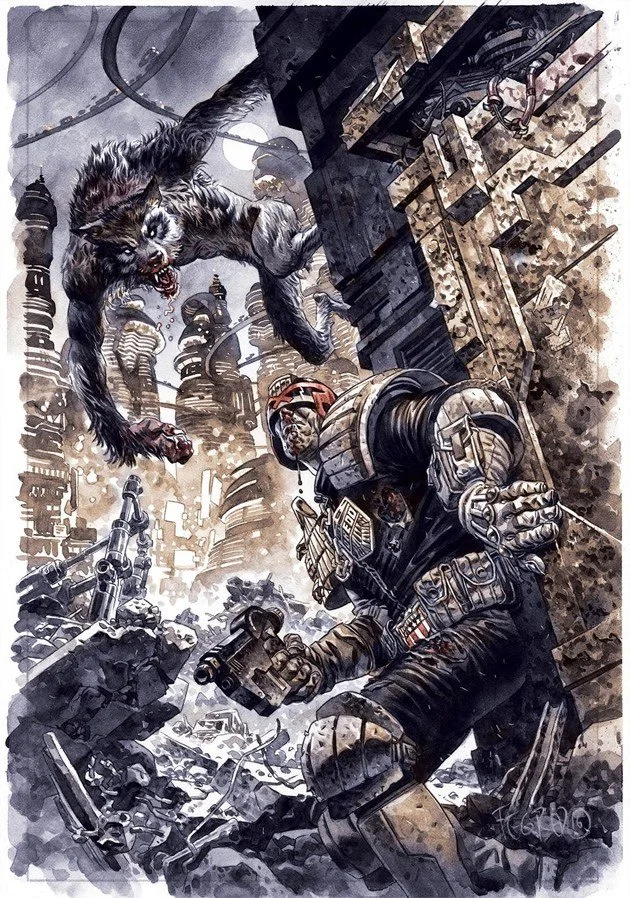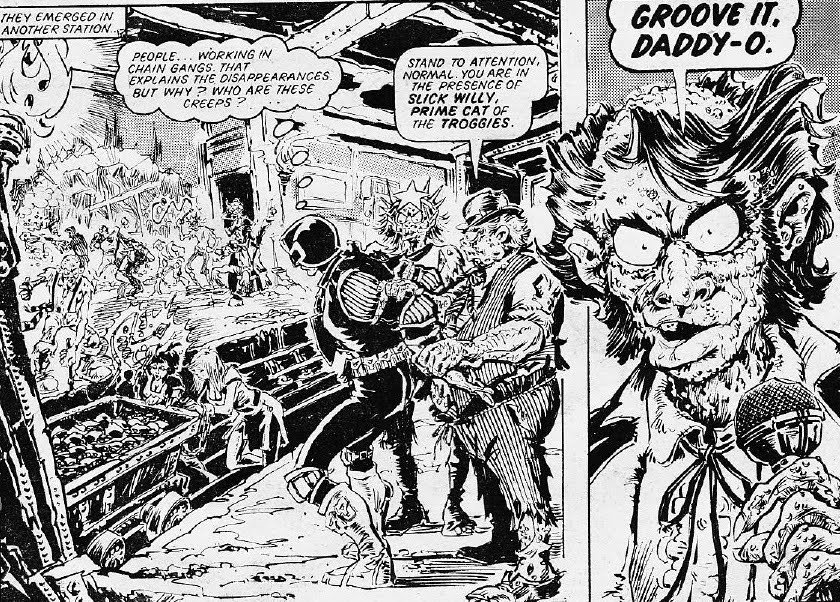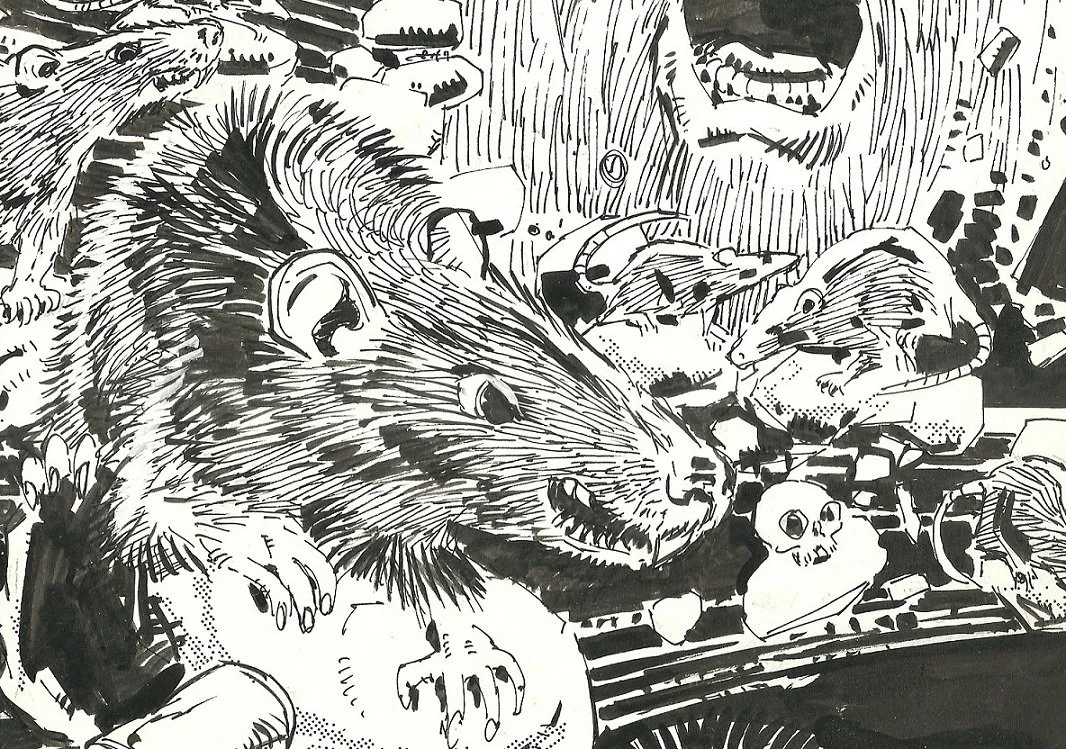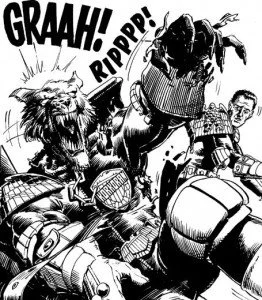Judge Dredd Locations: The Undercity
Welcome Dredd-heads to a guide to the world and locations of Judge Dredd. This time, we delve into a part of the Dredd verse I enjoy: the Undercity! This article is based on a blog entry by Mongoose Publishing but is also taken from Dredd sites all over the internet, so there shouldn't be any issues here. It's a long article, so grab a cup of synth-tea and enjoy.
The majority of Mega-City One citizens have no desire to visit the shadowy world of the Undercity. Even in emergencies, most would rather face the radioactive wasteland of the Cursed Earth rather than the ruined streets and buildings far below the massive slabs of City Bottom. Many remember the terrible monsters that have occasionally emerged to threaten the City and believe that the dark Underworld is crawling with similar creatures. Others are more straightforward and associate prestige with how high they live in the massive city blocks – the idea of living on City Bottom is repugnant; the thought of human life existing beneath the ground would fill them with horror and disgust. Most, however, do not know – or care – that the Undercity exists, too wrapped up with their everyday lives to bother with semi-mythical places.
A small minority of citizens are prepared to risk life and limb by organizing expeditions to the old cities. The adventurous, the desperate, or the just plain greedy dare to venture below the City into the darkness despite the Justice Department's strict prohibition. However, any visitor must be careful to ensure that they can exit the Undercity as easily as they entered it – City Maintenance squads quickly seal up any holes and fissures that they find, which can leave the unfortunate intruders stranded in the dingy caves and caverns! The Justice Department also has a vested interest in keeping the Undercity under control. Despite existing beyond their ordinary jurisdiction, judges are occasionally sent on missions into the darkness to eliminate some terrible threat or apprehend some particularly important fugitive. On more than one occasion, judges have been dispatched at the Undercity dwellers' request to deal with some new terror, but this is very much the exception rather than the rule. A chronic lack of judicial workforce has ensured that regular Undercity patrols are a thing of the past, but there is still a form of regular law enforcement. Judges can take the Long Walk into the Undercity when they retire from active service. Each takes an oath ‘to bring Law unto the Lawless – until death!’ but the midnight world of the Undercity is very different from the bright lights of Mega-City One, and only the most exceptional lawman can last for long.
Citi-Def Squad
Probably the most common visitors to the Undercity are members of the Citi-Def, intent on gaining some ‘real-life combat experience’ without the inherent risks of starting a Block War and the certainty of a long stretch in the Iso Cubes. Before the Apocalypse War, the Justice Department would allow carefully selected groups of Citi-Def access into the Undercity. During the conflict, the old cities even acted as a base for many units of guerrilla fighters, allowing them to launch lightning attacks against the occupying Sov forces before fading into the shadows of the buried streets and buildings. Following the extensive rebuilding programme that followed the massive destruction, many of the old entrances to the Undercity were sealed over, and the judges decided that to allow visitors to the underground world was simply too risky and difficult to administrate. Modern Citi-Def squads must take a more covert approach, sneaking in via the sewer system or boring through the concrete foundations of their city blocks.
Most Citi-Def squads take great pride in the fact that they are always ready for enemy action, and to this end, they tend to over-prepare somewhat, often carrying awkward or inappropriate heavy weapons or specialist equipment when embarking on a training mission. However, there is still a small minority of units that believe that they can deal with anything that the Underworld can throw at them, armed only with a handgun and a flashlight. It is usually only Citi-Def Officers and Jaeger squad commandoes that will embark on training missions to the Undercity – the average citizens that make up the ranks of the Citi-Def militia are either disregarded as unsuitable or are not interested in crawling about below the sewers, preferring to watch game shows and soap operas instead. A typical Citi-Def training squad will consist of an Officer accompanied by three to six Jaeger squad commandoes equipped with spelunker suits and Nightrider rifles with high-powered flashlights. Most carry enough rations to last for some considerable time, but some will be expected to live off ‘the land’ – surviving on only what they can catch and kill. Most find that they would instead go hungry.
Undercity dwellers tend to regard visiting Citi-Def as little more than an irritation – no matter how stealthy and well-drilled the part-time soldiers attempt to be, with their noisy equipment and blazing lights, they cannot help but be conspicuous. Most tribes and toggle clans are prepared to ignore or avoid the intruders, knowing they will return home to their environment when they get bored or hungry or killed by something more significant and meaner than them. Others, such as the peaceful Philadelphian trog tribes, will offer to act as guides, skilfully steering the intruders away from anything dangerous in return for some small trinket or piece of technology.
Criminal Cartels
Attracted by the fact that the Undercity is outside of the jurisdiction of the Justice Department, many large criminal cartels have had the idea of establishing a permanent base below the streets of the Mega-City. This is often a costly operation – transporting the raw materials to build a secure building from the surface world to the Undercity without attracting the judges' attention is an almost impossible task that requires elaborate planning and an enormous investment of resources. Many fall at the first hurdle, attempting to bore a tunnel large enough to transport large construction vehicles and robots through the slabs of City Bottom. Naturally, this is a rather noisy and conspicuous business that rarely goes unnoticed!
However, an organization that can establish a base can reap the benefits. The most typical Undercity base is used as a manufacturing plant, able to churn out anything from illegal weapons to drugs without much chance of discovery by the judges. In theory, the cartel should be able to flood the streets of Mega-City One with untraceable contraband. In practice, things rarely work out that way.
The Undercity dwellers themselves are a significant headache. Unlike the temporary visits by the Citi-Def squads or the transient, nomadic fugitives and refugees, the criminal cartels intend to stay permanently. Many tribes naturally take significant exception to this invasion of their territories. They will do their best to make the intruder’s lives as difficult as possible – sneaking in to steal anything that is not physically fixed down or simply murdering anyone they encounter.
A typical cartel base is a collection of modular, prefabricated buildings contravened in a specially cleared area of an old city or a repaired and re-fitted ancient ruin. Unable to connect to the City’s power supply, the cartels must ensure that a powerful generator includes enough power to run all the outpost’s needs. Large lighting rigs illuminate the surrounding area, and 30 – 50 human guards should ensure that the Undercity dwellers keep their distance. A team of construction and assembly robots toil endlessly at production lines, churning out illicit contraband, which must somehow be smuggled into the Mega-City. Short of investing a considerable amount of capital by installing one of the new teleport systems (which are unreliable even in the best of conditions), this will require a tunnel, which usually leads into some structure located on City Bottom – an old warehouse or Ecom unit is the most common – but the need to maintain a stable entrance into the world above is often the most challenging part of the operation, as the judges and City Maintenance alike will waste no time sealing the fissure without warning.
Refugees
Mega-City One has had more than its fair share of wars, natural disasters and invasions. Some citizens have become so accustomed to citywide death and destruction that they have established a well-practiced drill, which is put into effect as soon as the first signs of a threat appear. Thousands of citizens pack up whatever they cannot bear to part with and make for the relative safety of the Cursed Earth or the Undercity until the danger has passed, taking elaborate measures to escape over the city wall or burrowing through the slabs of City Bottom.
The residents of the Undercity usually avoid the refugees if possible – they know that these ‘upsides’ will only enter their shadowy home in the most desperate emergency, and they should hide should the threat extend below the Mega-City. Sometimes, though, the fleeing citizens find no haven as the crisis dramatically affects life in the Undercity. The Sisters of Death's corrupting influence reached into the simple souls of the deep triggers during the Necropolis crisis, sending them on terrible rampages of death and destruction. During the Judgement Day war, the dead of the Undercity arose to attack the living, just as happened all over the world, and the most recent influx of refugees fought side by side with the Undercity dwellers. Many thousands of troggies, human tribe members and refugees were killed in the brutal hand-to-hand fighting. The Undercity has never quite recovered from the repercussions of this terrible battle – especially considering that some of the undead remained animated after the defeat of the necromancer Sabbat. The Apocalypse War resulted in the population of the Undercity almost doubling, as many of the citizens that had fled to hide from the occupying Sov forces had no homes to return to afterwards. Others discovered that the life of an Undercity dweller was more exciting than their tedious existence and decided to stay; a few did not believe that the Mega-City One forces could have defeated the unstoppable Soviet war machine, dismissing any subsequent news reports as propaganda intended to flush them out of hiding. Some were still suffering from the Block Mania contamination and had become so involved in fighting the various Undercity tribes that it simply never occurred to them to go home!
What constitutes a refugee party varies enormously, from a lone individual fleeing via the sewer system to a massive, hundreds-strong column that has made its way beneath the ground using enormous construction vehicles or robots to bore a vast tunnel. Many blocks have implemented an evacuation drill to signal an emergency. Still, in the event of an alarm, most citizens will panic, grabbing the first thing that comes to hand (no matter how inappropriate or useless) and fleeing. Most refugees will be unarmed, but about one in ten are equipped with small arms or hand weapons.
Fugitives
A citizen fleeing from the judges is often prepared to take desperate measures to avoid a long spell in the Iso Cubes. Those who can afford it make use of a perp runner, a criminal highly skilled in smuggling fugitives out of the jurisdiction of the Justice Department. Even though it is the closest ‘judge-free’ area, few perp runners will try to deposit their charges into the dark Underworld. Boring a tunnel through City Bottom is a time-consuming, costly exercise that often attracts the attention of the very people that the runners are intent on avoiding. In any case, even ruthless criminals find the thought of life in the Cubes preferable to struggling for survival in the Undercity.
Most fugitives who find their way below ground are unaided, squeezing through fissures or navigating through the sewer system. It is usually only the most evil of criminals who are prepared to try to make themselves a new life in the Undercity – vile murderers tempted by the lack of judicial interference hampering their ‘fun.’ These individuals often join with the most violent Undercity tribes, frequently rising relatively high in rank.
Tourists
Taking a tourist trip to the buried cities is a relatively recent craze. Arranging package trips to the Undercity is illegal, but this only adds to the attraction. For an exorbitant fee, groups of citizens are smuggled below City Bottom, taking rooms in a once majestic hotel or famous landmark. At the same time, costumed entertainers provide re-enactments of historical events for the tourists” amusement. The opportunity for sightseeing attracts many visitors, but they are frequently disappointed – it is too dark to see anything in most of the Undercity.
Most of these tours are arranged by totally unscrupulous conmen, intent on draining their customers of cash for as little work or effort as possible. Others are more sinister – chump dumpers who simply abandon their charges in some dark corner of the Underworld to be killed by froggies or some monster, or even slavers who had no intention of taking their customers to anywhere other than a Cursed Earth slave market.
Even if tourists have been forewarned of the dangers of the Undercity, they are usually poorly equipped to survive below ground, often bringing no more than a video camera and lousy taste in clothes. Some tourists are intent on a ‘hunting trip’ to the Undercity, loading up with heavy weapons and determined to bag a trophy – similar to the ‘dinosaur hunters’ that have been venturing into the Cursed Earth for many years. The Undercity is a very different environment to the Cursed Earth, which requires a very different approach – many have failed to consider this and have paid the price.
Most Undercity dwellers, except the most territorial and aggressive, ignore and avoid sightseers. A non-violent exception is the pathetic toggle sub-breed known as wretches – the mortal, blind creatures tend to crowd around the visitors, begging for a few scraps of food. This approach does not usually work, but the tourists regard the creatures as ‘charming’ parts of the scenery. Naturally, all tribes will react against any violent act, often tracking down and swiftly eliminating any group that seems to be a threat to them.
Treasure Hunters
Seedy bars and clubs in the Mega-City are full of tales of the riches of the United States left abandoned in the old cities before their burial. In a town where any pre-Atom War artifact is considered a priceless collectable, many more gullible citizens are prepared to risk life and limb to visit the savage Underworld beneath their feet. Many pongos can make an acceptable profit selling ‘treasure maps’ detailing the locations of valuable items. Most of these are copied from old atlases, giving a vague idea of some famous landmark that may still contain some valuable thing; others are entirely fictional pieces of artwork that ‘guarantee’ the owner will find huge riches but bear no relation to reality. A few are genuine, accurately showing a location rich in valuable items – Bloomingdale’s department store in New York is a favourite, as it once claimed that it stocked ‘everything,’ or the old United States Mint in Philadelphia, still reputed to hold millions of credits worth of old coins.
Most treasure hunters are enthusiastic amateurs who believe they can conquer the Undercity if equipped only with a spade and a flashlight. This is almost always a fatal mistake – most landmarks are occupied, or at least claimed, by the various Undercity dwellers, who take great offence to outsiders arriving on their territory unannounced to steal their property. Others come better prepared, with bigger bots, ultrasonic scanners, adequate lighting, and a selection of weapons to keep the threat of the triggers at bay. Most realize that they have been hoodwinked and quickly give in – everything valuable left behind has long since been looted or broken in the years since the long night began. Some are more patient or stupid, often spending a fortune in time and money tearing old buildings or monuments to pieces, seeking valuables that no longer exist. The United States Mint, for example, has been visited by so many different groups of fortune seekers that the fortress-like structure resembles a honeycomb, riddled with tunnels and pits and verging on collapse.
A few treasure hunters become successful, finding a cache of priceless lava lamps or unopened self-assembly bookcases, which they then sell for a fortune on the antiques black market. These exceptional individuals can make a perfect, if illicit, living from their underground activities. Others make a living by scavenging illegally through the Mega-City sewer system, seeking valuables other citizens have accidentally flushed away. Even these ‘sewer scrapers’ are sometimes surprised by what they find washed up in storm drains or channels.
The Junk Prospector
The Mega-City antique market places excellent value on artifacts from 20th and 21st-century popular culture – items that a contemporary individual would regard as rubbish or of short-term worth. Ancient newspapers and books are often banned by the judges, which only adds to their appeal – old copies of the New York Times, comic books or one-time blockbuster novels find their way onto the Justice Department’s vetoed list, boosting their ‘collectable’ value no end on the black market. Other items can be legally owned but are extremely rare. Millions once produced ancient craze items such as Rubik’s cubes, but only a handful have survived into the 22nd Century. Even packaging is valuable – tins, bottles and carrier bags can fetch millions. It is not unknown for a collector to kill to obtain some rare item whose original owner simply threw it away.
The absurd prices that some citizens are prepared to pay for an old Wellington boot or a Sylvester Stallone movie poster naturally attracts many perps into ruined Cursed Earth towns and cities or the buried conurbations of the Undercity in search of valuable junk. The savage environment or its inhabitants kill many before they can find anything of value, but a few manage to locate a valuable ‘seam’ of junk. Some still speak of the legendary Filmore Faro, who rediscovered the town of Memphis in the Cursed Earth and made his fortune selling Elvis memorabilia to the Sov block. Some still speak in awe of his priceless coat made from ring-pull tabs but always seem to ignore the fact that he was driven utterly insane as his brain was fried in the radiation-saturated wasteland before he chanced upon the Old City. The chance of making a considerable profit always outweighs the dangers.
The Justice Department
The forces of the Justice Department are usually the only legitimate visitors to the Undercity. Unlike most intruders, the judges make use of the great Undercity Gates instead of having to find a tunnel or fissure through City Bottom – although it is not unheard of for a team of judges to be dispatched through a hole, even if it only to see where it leads. However, the judges lack the workforce to do anything other than occasional visits, usually only when some pressing emergency is brewing in the dark Underworld. Unlike the Cursed Earth, there is little or no monitoring of the Undercity, no circuit patrols or Hotdog Runs to give an occasional update of the situation below the City. It is often years between missions – the judges often find that any information they possess is hopelessly outdated when embarking through the Gates.
Occasionally, it is the Undercity dwellers who request the judges' presence. They are fully aware that the great judges can deal with threats they cannot cope with – triggers have emerged to request help against the terrifying Vampire Cloud and to end the insane domination of Brad Evil, for example. The judges know that the Troggies will only emerge into the hated light in the most desperate situations and usually take their complaints seriously enough to investigate.
More often, though, the judges will venture into the Undercity to deal with some menace that has emerged to attack the citizens of Mega-City One. These threats vary from the relatively mundane – such as Slick Willy and his Troggie cult’s abduction of dozens of upsides to act as enslaved people in his mad plan to bring the Mega-City crashing down in 2099 – to quasi-supernatural monsters emerging to bring carnage to the roads and pedways – for example, the werewolf attacks in 2105 or the Holy Fiend murders of 2114. Most residents of the Undercity know enough to make themselves scarce whenever the judges venture into the Undercity – even the dumbest toggle realizes that trouble always follows the black-clad law enforcement officers. He will need to find a safe place to hide until the shooting stops!
A judge’s standard-issue equipment is usually enough to deal with anything the Undercity can throw at them. With their access to the large Undercity Gates, the judges are among the only visitors who can bring any vehicles. However, anything larger than a Lawmaster will have great difficulty on the shattered streets.
The Undercity Long Walk Judge
No judge is expected to remain on the streets forever. Even the toughest lawman knows that one day, their usefulness will come to an end, and they will be forced to retire. However, expecting old judges to live their final days lazing around in a Crock Block would be foolish. Once retired from active service, there are still several valuable roles that they can fulfil. The most experienced are allowed to pass on their knowledge gleaned from their decades on the streets by becoming Judge Tutors in the Academy of Law, training the next generation of Cadets in the statutes and application of the Law. Others are given administrative roles in Sector Houses, where they can guide and assist their former colleagues. But there are always a few who find such tasks tedious. The only alternative is the Long Walk, when a retiring judge is allowed to leave the confines of the Mega-City to bring the Law to the Lawless in the wastelands beyond the Justice Department’s ordinary jurisdiction. Most who decide to ‘take the hike’ choose to venture into the radioactive wasteland of the Cursed Earth, but the blackness of the Undercity is also an option. The Long Walk Judges are the only official law enforcement in the shadow-cloaked Underworld. A judge who becomes disillusioned with the Justice Department can also take the Loto, but most choose to renounce their authority and become an ordinary citizen simply. Unfortunately, the threat of the Long Walk has been used as the ultimate disciplinary measure, particularly during the reign of Chief Judge Silver and the second term of Chief Judge McGruder. Corrupt judges suspected of committing terrible crimes were permitted to take the Long Walk as the honourable alternative to a sentence on Titan or a Cursed Earthwork farm. Unfortunately, beyond the strict control of the Justice Department, these hazardous individuals tended to run amok. Some of the most notorious maniacs and murderers to wander the Undercity and the Cursed Earth were former Long Walk judges.
A grand ceremony marks a judge taking the Long Walk. Twenty-one judges flank their departing comrade, each saluting him with a single shot as he passes. The traditional lament is recited as he exits the Mega-City for the final time. As the gates to the City clang shut behind him, the judge is alone for almost the first time. From now on, he can only rely on himself – there is no backup, no comrades to come to his aid should he get into trouble. He has only his training and experience to keep him alive in a new, hostile environment. It takes a truly exceptional individual to survive longer than a few months as a Long Walk judge.
Like many habitats in the 22nd Century, the Undercity is a sealed environment. However, unlike the strictly controlled and regulated life support systems in the domes of Luna-1 or Viking City on Mars, the Undercity is an example of a closed environment that has been allowed to run out of control, with no monitoring whatsoever to keep the various life forms and habitats in a stable condition. The dark caverns have become the epitome of ‘survival of the fittest’ – only the most robust, most adaptable or numerous creatures can survive at any time. Isolation from regular sunlight has also dramatically affected most plant life – few species have survived the burial of the cities. Only a few mutant species of trees and flowers have survived in isolated patches. However, many new species of fungus and mosses have become common, thriving in the decayed darkness of the streets and buildings.
Structures
There is a vast diversity of artificial structures in the Undercity. When the cities were buried, homes, offices and factories were evacuated and left empty. Lack of maintenance eventually took its toll, and many ancient and historic buildings have collapsed. However, some have been appropriated by Undercity dwellers who have adapted them to suit their needs. Some have been reinforced into fortresses; others have been torn to pieces and used to make new buildings.
The Concrete Sky: The great concrete dome that covers most of the Undercity is almost universally known, incorrectly, as ‘The Concrete Sky.’ In many areas of New York, the enormous structure is so far above the ground that it is almost impossible to see, giving the impression the old City is cloaked in a particular night. The roof is only a few feet above the ground in other areas, forming claustrophobic caverns that constantly drip with freezing condensation. Giant stalagmites and stalactites are beginning to form in some areas – great, teeth-like growths that block large sites of the Undercity. The concrete sky possesses terrific tensile strength as it has to support the entire Mega-City, but individual segments are pretty brittle. Many tribes have developed the ability to tunnel through the concrete walls, instinctively ensuring that the stability of the structure as a whole is maintained. The concrete sky is reinforced with hundreds of plastic-steel girders, which makes it far more challenging than regular concrete.
Philadelphian Tunnels: Philadelphia was only the second United States city to be buried beneath the Mega-City, and the designers chose a radically different method. Colossal vaulted chambers were built over many vital buildings, and every street was converted into a tunnel to form a massive labyrinth before millions of tons of concrete smothered the entire City. Philadelphia became a claustrophobic nightmare of a town regularly flooded by the stinking, fetid waters of the old Delaware River and overflow from the Mega-City sewer system. The tunnel and chamber walls are somewhat more substantial than the concrete sky that covers the rest of the Undercity but are little more than a thin covering of reinforced vaulting. The concrete that covers Philadelphia is considerably thicker than most of the rest of the Undercity – in some places, over a mile. Some tribes of the stunted Philadelphia trogs can excavate their passageways through the thick walls. Some areas have become a twisting, confusing labyrinth of low burrows interconnecting with the ‘official’ tunnels.
Sewer Tunnels: Sandwiched between the Mega-City and the Undercity is the vast sewer network, a convoluted warren of interconnecting tunnels and vaulted chambers. Some have speculated that the sewer system can reach all areas of the Mega-City. Still, only a perp with a firm stomach would use the tunnels to move from one place to another. The design and layout of the tunnels themselves tend to vary enormously from ancient, brick-built three-foot high passageways to enormous reinforced tunnels and chambers to futuristic, plastic-metal clad shafts. However, before long, every tunnel looks the same – dark, claustrophobic and extremely smelly. There are further dangers to investigating the tunnels – it has developed its micro-ecology of savage life forms, from the giant white gators to millions of huge, vicious rats. There is further danger – explosive methane gas, an unavoidable side effect of the decay of sewage. Many Mega-City companies profit from mining this gas as a valuable resource, but pockets quickly build up in hard-to-reach places. If exposed to fire or an explosion (such as a gunshot), a gas pocket will detonate as if it were a hand bomb. Sealed maintenance holes are placed on City Bottom and beneath city blocks at regular intervals to allow city maintenance teams access to the sewers – ordinary citizens must keep them out of them at all times. Anyone found attempting to access the sewers without a valid permit will earn themselves a minimum of six months in the Iso Cubes should they be caught by the judges. Maintenance hole covers are usually constructed from a durasteel alloy, firmly locked and sealed against tampering.
Pre-Atom War Building: Much to the horror and bemusement of the citizens of Mega-City One, most of the shops and houses found in the old cities consist of squat, boxlike buildings a mere two or three storeys tall. Once, these were sturdy homes and places of business, but the decades buried beneath the City have left little more than shattered, worn-out ruins. Over the years, time has taken its toll, and many old buildings have collapsed into bankruptcy, leaving nothing but a hollow shell or broken rubble. Some facilities have survived more or less intact – these have usually been taken as homes by some smaller tribes. Broken masonry and scavenged materials often shore up collapsing or damaged buildings, making even serviceable abodes appear to be little more than piles of rubble. A typical low-level building has two storeys plus a basement or cellar area. The ground floor is divided into four to six rooms, including a kitchen and a living room; the first floor is usually subdivided into bedrooms. The basement area most often consists of a single, large area. However, the function of any occupied building has long since been forgotten. Houses in Philadelphia suffered an even stranger fate – many were smothered in concrete when the tunnels were built, leaving only a single façade with only the occasional accessible room.
Pre-Atom War Sky-Rise Tower: The majestic skyscrapers that once dominated the skylines of many cities in pre-Atom War America would be regarded as quaint, low-level con-apts by the residents of the giant Mega-City. Even the tallest surviving building in the Undercity – the Chrysler Building in New York – is less than a quarter of the height of an average-sized city block. Nevertheless, these structures are still regarded as valuable resources and their ownership is usually hotly contested by many of the Undercity factions. Even collapsed or ruined skyscrapers are regarded as a valuable commodity – bricks, girders and rubble are always needed to shore up the slowly decaying habitats occupied by the Undercity dwellers. A typical sky-rise tower stands fifty storeys tall, although only the mighty New York dome can house such a large structure. The concrete sky cuts off many tall buildings, their top few storeys embedded in the great concrete mass.
Troggie Hut: Most varieties of troggies have become adept at constructing themselves primitive shelters. As there are no natural weather patterns in the Undercity, these huts are generally used as protection against other underworld residents and are reasonably challenging. Troggie huts usually consist of a room about ten feet square, with walls made from salvaged junk or the remains of an ancient building, torn apart and reassembled in typical ramshackle troggie style.
Philadelphian Trog Roundhouse: The Philadelphian trogs are somewhat more sophisticated than their cousins that occupy other areas of the Undercity, constructing their style of buildings that, strangely, resemble an ancient Celtic roundhouse. Philadelphian trog roundhouses are large, circular buildings constructed using ancient methods but with more modern materials – salvaged metal and brick rather than wood and leather. As they are nomadic, the Philadelphian trogs ensure that their homes can be quickly dismantled to allow them to move easily – this is typically to escape from the floods from the black water of the Delaware River that wash through their tunnel homes regularly. Naturally, these temporary and prefabricated structures are more fragile than permanent ones.
Flora
Isolated from natural sunlight, very few plants thrive in the Undercity. Most forms of vegetation have withered and died in the shadows, but, like their human and animal equivalents, a few mutant species have adapted to live without ultraviolet light and heat.
Fungus: Unlike most plant life, fungus thrives in the cold, damp darkness that forms most Undercity. Edible forms of fungus form a staple diet of many less aggressive species, such as the great albino pigs known as hawks, and many areas have been cultivated into huge ‘fungus farms’ by tribes of humans and the more docile froggies. Other forms of fungus are less beneficial. Some are deadly poisonous, bringing a slow and lingering death to any foolish enough to consume it. Other species bring decay, consuming and corrupting any substance that it can gain a foothold.
Moss: Moss is probably the most common plant in the Undercity. Moss requires little water and can grow almost anywhere. It tends to cover vast areas of the desolate streets and buildings of the old cities. Unfortunately, this plant has very little nutritional value, although many species – such as the pathetic sub-humes known as wretches – are forced to eke a miserable existence grazing on it. Another form of moss is far more valuable – the so-called ‘glow moss’ is a mutant species of luminescent moss, often cultivated on walls and ceilings to provide dim lighting.
Mutant Vegetation: Many mutant plant species have appeared since the burial of New York, although, as yet, none have become particularly common. Most tend to be weak, capable of surviving in the darkness or the toxin-saturated slime of the Big Smelly. Others are more robust – a few trees have survived, and clusters of pale grass exist in isolated places. Others have developed along more sinister lines, such as the deadly Boston Strangler Vine and the parasitic Hoxton Creeper.
Dead Vegetation: Dead and decaying plants are the most common sight in most undercity areas. Most of the dark Underworld was at one-time rural fields and wastelands covered by the tremendous concrete foundations of the Mega-City, leaving the unfortunate vegetation cut off from vital life-giving heat and light. Most of the Undercity is cluttered with dense mats of stinking mulch.
Fauna
Humanity is not the only species to make a home in the Undercity, although they always regard themselves as the most important inhabitants. Many creatures and monsters endure life in the darkness. However, there are several other forms of animals native to the Undercity.
Rats: Rats are by far the most common inhabitants of the Undercity – some have estimated that there are over a thousand rats for every human resident. The ruins of the Undercity make an ideal home for these tiny scavengers, with thousands of nooks and crannies where they can make nests and warrens. The rats’ prolific breeding rate ensures that the Undercity dwellers never go hungry – in fact, rats have become the staple diet of nearly every creature that calls the Undercity home. However, the rats are not merely defenceless victims. The animals possess a high level of natural cunning and occasionally ‘gang up’ on isolated individuals, gathering in groups of dozens or even hundreds to form a deadly tide of squirming bodies. Usually, though, they will only prey on the weak and defenceless – babies and infants are their favourite targets. Many a time, an un-attentive Undercity mother will leave a cradle for a few moments only to find nothing but gnawed bones and a few pitiful scraps of flesh on her return. In some areas, the rats have grown to colossal proportions – some have spoken of savage monsters the size of large dogs or ultra-intelligent, two-headed monstrosities somehow guiding the others.
Gators: No one seems sure how alligators, usually only found wild in tropical areas, came to live in the sewers of many American cities, but their existence is undeniable. Although the larger specimens have emigrated to the cleaner waters found in the Mega-City sewer system, the old sewer networks beneath most of the old cities still harbour a healthy population of gators, and the swamp-like tunnels of Philadelphia make an ideal home for the fierce beasts. Naturally, the lethal, armour-plated reptiles are greatly feared by humans and troggies alike.
Werewolves: Lycanthropy originated in the Undercity. No one knows the whole story, but a strange pool in Central Park was found to contain mutagenic bacteria that could transform a human into a savage, wolf-like hybrid. Before long, many areas of New York had become overrun with terrifying, savage monsters. Fortunately, Judge Dredd could eliminate the mutagenic pool and most werewolves, but a few escaped. Although far less threat than in previous years, werewolves are terrible opponents. Many tribes will put great effort into wiping out a werewolf nest should they discover one. Werewolves kill anything that moves, but nothing can eat the flesh of a werewolf without risking transforming into a similar creature. However, at least one tribe – the savage Grid Iron Union – takes advantage of this phenomenon. Gridiron grunts have been known to deliberately eat werewolf meat to spark transmogrification to become the elite' dogfaces,’ fearsome monsters loosened at rival tribes before a battle. The Undercity dwellers have never had access to the cure for lycanthropy, so the transformation is permanent.
So there you have it. Home to crazy, the dangerous and the unloved. It's an excellent setting for the games of Judge Dredd. I hope you have enjoyed it. Please drop me a comment and come follow me on YouTube. Cheers!
